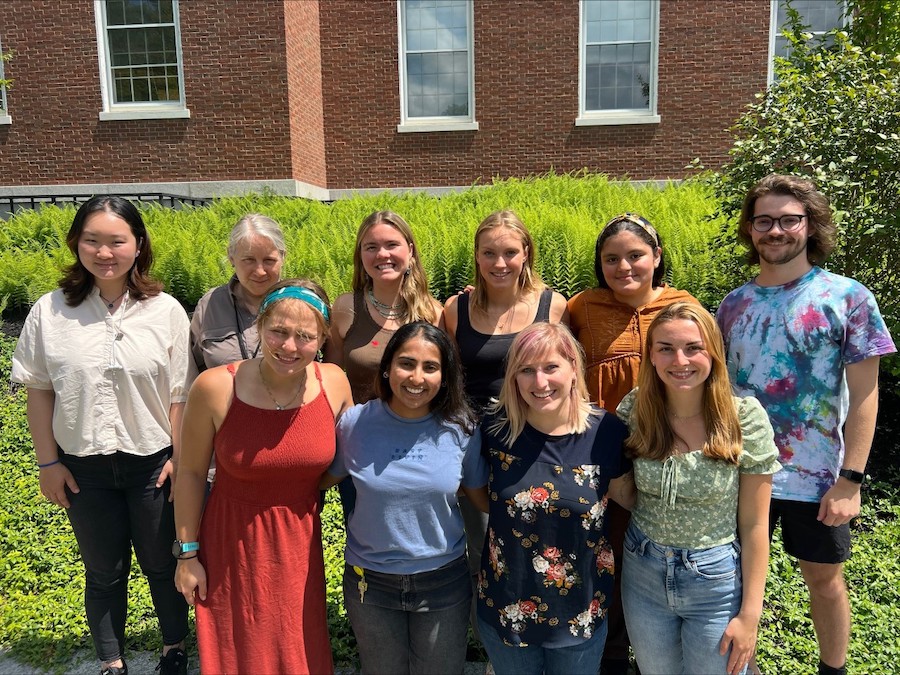In Honeycutt Lab, Students Investigate Lingering Impacts of Early-life Adversity
By Rebecca GoldfineThis summer, eight students in the lab of Assistant Professor of Neuroscience and Psychology Jennifer Honeycutt are studying how trauma experienced in infancy or youth can affect brain development and behavior.

"The big context we're focused on is trying to understand the short- and long-term consequences of early-life adversity," Honeycutt said. "Most of our work in the lab dovetails with that bigger picture."
To collect an array of neurological, genetic, and behavioral data to help answer their questions, the lab teams are studying baby rats that have been removed from their mother for a few hours a day during the first weeks of their lives. This period in a rat's life correlates to a human's neonatal phase and young childhood.
“We’re particularly interested in looking at a caregiver deprivation model and comparing male and female responses as they relate to later anxiety-like behaviors,” Honeycutt said. “In the human world this is what we see in places like underfunded orphanages, refugee camps, and detention centers at the US-Mexico border, where young children are separated from their parents.”
The eight students this summer have funding both from Honeycutt's INBRE grant [IDeA Networks of Biomedical Research Excellence] and fellowships from Bowdoin. Their projects focus on specific areas within the lab's larger mission.

Fostering Mentorship in the Lab
Honeycutt—who grew up in New Hampshire—graduated from Colby College in 2010 and earned her PhD in behavioral neuroscience from the University of Connecticut.
That fact that she is the first in her family to obtain a college degree is significant for some of her students. Khushi Patel ’23, a first-generation student as well, noted that it was one of the reasons she felt comfortable approaching Honeycutt to seek a lab position and ultimately pursue an honors project.
"Jennifer is a great mentor," Patel said. "You're never afraid to go to her if you've made a mistake. She's always supportive and understanding. She fosters a great relationship with her students."
To cultivate peer-to-peer mentorship, Honeycutt assigns lab teams of two, pairing a more experienced researcher with a less experienced one. While the four seniors in her lab are all working toward an honors thesis, the sophomores and juniors are gaining the skills and knowledge they need to pursue a thesis one day as well.
"We all teach each other, it's very collaborative," Sydney Bonauto ’23 said. "There is no hierarchy. Everyone makes the chemicals and washes the dishes."
Epigenetic Changes: Team Emma Noel ’23 and Yanevith Peña ’25
"Characterizing the Effect of Early Life Adversity on Sex-specific Behavior and DNA Methylation Patterns over Development"
Within the lab's overall mission of studying brain development following adversity, Noel and Peña are more narrowly looking at DNA methylation, or the epigenetic changes in DNA following stressful experiences. Epigenetics refers to the study of how environments and behaviors influence gene expression.
"There is some thought that there could be DNA methylation signatures [in rats that have undergone maternal separation] that could be predictive of later-life anxiety," Noel explained. "We're trying to see if we can characterize that methylation and what brain regions it might be in."
They're also examining whether male and female brains respond differently to adversity experienced in youth, and whether developmental time points impact the manifestation of anxiety-like behaviors and neurological changes.
Peña said she was drawn to the lab because of its implications for humans. "Honeycutt's research interests me because of how translational it is," she said. "Looking at early-life adversity, especially maternal separation, can help us determine the psychological damage that can occur with children. The real-life aspect really appeals to me."
Noel agreed that the lab could open new frontiers in mental health treatment. "As I go through life, I want to give back and make meaningful change, and while preventative treatments for mental health are very tricky, if we’re not doing the research on them, they're never going to happen."
Advancing with AI: Team Lucy O'Sullivan ’23 and Nuanxi (Sissi) Feng ’24
"Using Artificial Intelligence to Understand the Effects of Ketamine on Anxiety in Rats after Maternal Separation"
O'Sullivan and Feng are analyzing a behavioral data set that contains information about how rats react to the drug ketamine, which is used to treat depression, but may also impact anxiety.
This data—captured in videos—shows that female rats respond inconsistently to anxiety-producing stimuli, in this case ultrasonic vocalizations. (Rats communicate alarm to one another with sounds imperceptible to humans.) O'Sullivan and Feng are beginning an analysis of these reactions by training a computer to detect quick and subtle behaviors that humans can't easily observe.
"The ultra-powerful software can analyze how rats in general respond to ultrasonic vocalizations, as well as show the nuanced ways females respond to the anxiety-causing stimuli of ultrasonic vocalizations," O'Sullivan said.
To teach the software to "see" these nuances, O'Sullivan and Feng manually tag the rats’ body parts—the nose, paws, and tail—and instruct the computer to follow them and log their movements, Feng said.
They are building a record of these "sub-second behaviors, to give a grammar to the body language," O'Sullivan said. "I like that phrasing to describe our work because we’re trying to detect whether the rat, for example, twitches and then steps in response to one stimulus."
Once the computer can track these small movements, it can count their frequency and other variables. "It can give you all these data points which are valuable," O'Sullivan continued. "We have a lot of transcriptive and genomic data, but not a lot of big behavior data. We can use these AI programs to understand ethological behaviors."
Brain Development: Team Khushi Patel ’23 and Cash Reynolds ’24
"The Effect of Early-life Adversity on Early Basolateral Amygdala Projections Activating Cells in the Prefrontal Cortex"
The study Patel and Reynolds are running includes both behavioral experiments and surgery. To gather their behavioral data, they place rats on an elevated maze that has both exposed areas and protected areas with high walls. (In the experiments conducted in Honeycutt's lab, students work with both control rats—those that have not experienced maternal separation—and rats that have been removed from their mothers.)
"We hypothesize that if the rats exhibit more anxiety, they'll stay in the covered sections," Patel explained, and that rats that have experienced early-life adversity will display more anxiety. "If they're less anxious, they'll be more willing to explore more into the open area.”
The behaviors are guided by neural mechanisms, which are established over the duration of a rat's life, Reynolds said, and can be detected under a microscope. Specifically, this team is testing the hypothesis that experiencing early adversity leads to a sex-specific acceleration of the development and activity of key brain regions involved in anxiety. They are doing this by stimulating the amygdala—a region strongly linked to emotion—and characterizing the number and types of cells that are recruited within the prefrontal cortex—a region important for overseeing behavioral output.
So the team is also dissecting and analyzing rat brains to determine which cells are activated, and "if there is an age dependency or a sex difference," Patel explained. "We're trying to hone in on what kind of cells are activated and quantify how many of them are affected."
Responding to Ambiguous Threats: Team Sydney Bonauto ’23 and Adelaide Hocking ’24
"Ultrasonic Vocalization Playback as an Assay at both Neural and Behavioral Levels: Implications for Understanding Adversity-induced Emotional Dysfunction"
Rats communicate to one another with different vocalizations that humans can't hear, with some sounds signaling that a threat may be near while others communicate a warmer intention, almost like the equivalent of a giggle in humans.
Last summer, Bonauto collected data on how rats respond to these negative and positive ultrasonic vocalizations at three developmental stages: juvenile, late adolescence, and young adult. She and Hocking are also focused on sex differences, which "are very important when considering development and responses to affective/emotional stimuli," Bonauto said. "It’s also important in behavioral neuroscience in general."
This summer, Bonauto and Hocking are trying to find out whether rats that have experienced maternal separation exhibit a greater reaction to the alarm calls than the control rats. Honeycutt explained, "We are trying to understand how early-life adversity might put you at a higher risk of being hyper-vigilant in instances of ambiguous threats.”
Data is gathered by placing rodents in a large, open box and recording them for twenty minutes as they are played the alarm vocalizations and the friendly vocalizations. A computer can quantify how much time the rats spend crouched along the box perimeter, which they do if they're anxious, versus in the open interior, where they venture if they're feeling confident.
"We time the duration they spend in those zones, as well as other variables like velocity and distance traveled," Bonauto said. "I am looking forward to figuring this out—we have all these numbers, but what do they mean?"
The team is also performing a chemical analysis of the rats' brain tissue to see which region and cells have been involved in this activity. They're focusing on six regions associated with anxiety and emotional processing.
"And we're looking at cells that play an inhibitory role and cells that are excitatory and look at ratios between them to see how much they're expressed in these brain regions," Bonauto said. "We're interested in seeing the mechanisms that are propelling the behaviors we see."